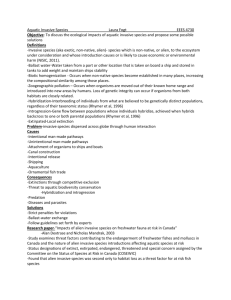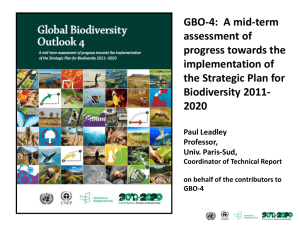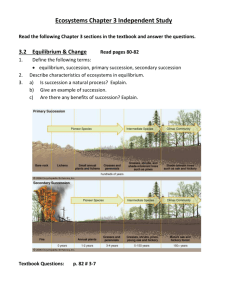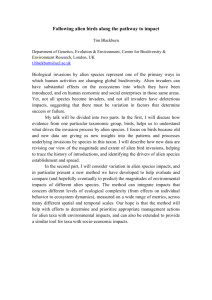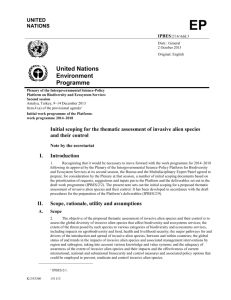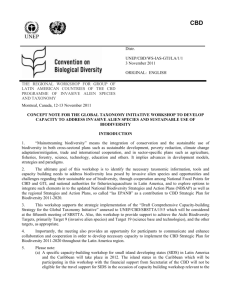invasive alien plant species - Irente Biodiversity Reserve
advertisement
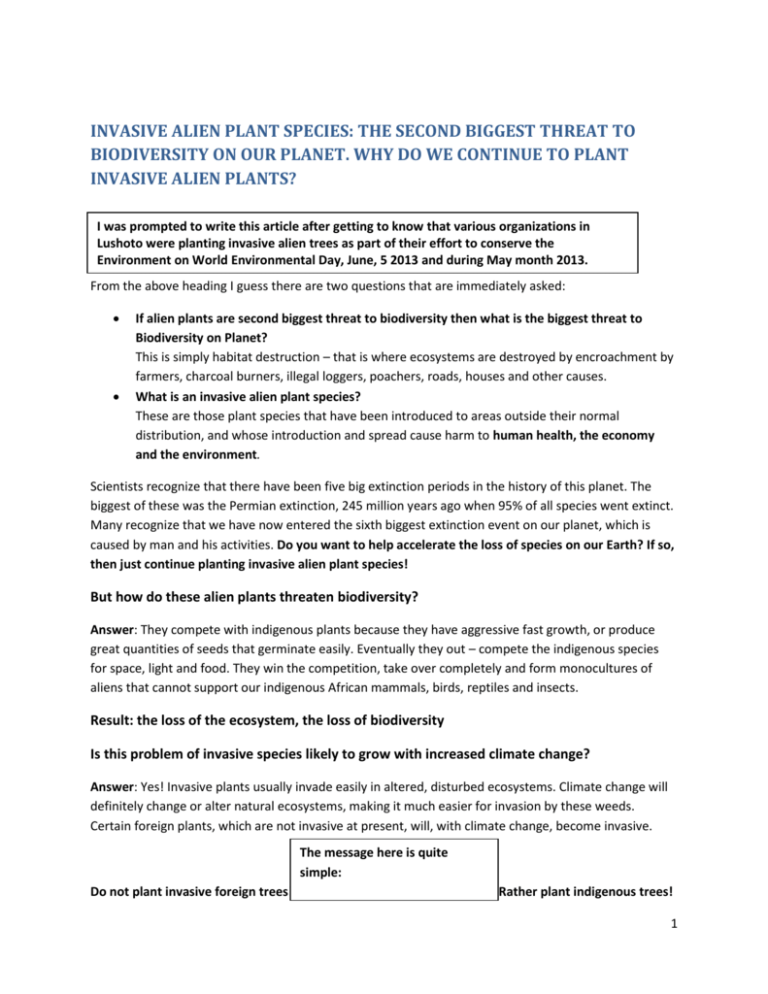
INVASIVE ALIEN PLANT SPECIES: THE SECOND BIGGEST THREAT TO BIODIVERSITY ON OUR PLANET. WHY DO WE CONTINUE TO PLANT INVASIVE ALIEN PLANTS? I was prompted to write this article after getting to know that various organizations in Lushoto were planting invasive alien trees as part of their effort to conserve the Environment on World Environmental Day, June, 5 2013 and during May month 2013. From the above heading I guess there are two questions that are immediately asked: If alien plants are second biggest threat to biodiversity then what is the biggest threat to Biodiversity on Planet? This is simply habitat destruction – that is where ecosystems are destroyed by encroachment by farmers, charcoal burners, illegal loggers, poachers, roads, houses and other causes. What is an invasive alien plant species? These are those plant species that have been introduced to areas outside their normal distribution, and whose introduction and spread cause harm to human health, the economy and the environment. Scientists recognize that there have been five big extinction periods in the history of this planet. The biggest of these was the Permian extinction, 245 million years ago when 95% of all species went extinct. Many recognize that we have now entered the sixth biggest extinction event on our planet, which is caused by man and his activities. Do you want to help accelerate the loss of species on our Earth? If so, then just continue planting invasive alien plant species! But how do these alien plants threaten biodiversity? Answer: They compete with indigenous plants because they have aggressive fast growth, or produce great quantities of seeds that germinate easily. Eventually they out – compete the indigenous species for space, light and food. They win the competition, take over completely and form monocultures of aliens that cannot support our indigenous African mammals, birds, reptiles and insects. Result: the loss of the ecosystem, the loss of biodiversity Is this problem of invasive species likely to grow with increased climate change? Answer: Yes! Invasive plants usually invade easily in altered, disturbed ecosystems. Climate change will definitely change or alter natural ecosystems, making it much easier for invasion by these weeds. Certain foreign plants, which are not invasive at present, will, with climate change, become invasive. The message here is quite simple: Do not plant invasive foreign trees! Rather plant indigenous trees! 1 The Usambara Mountains have 684 indigenous (native) tree species and subspecies, so there is a big choice! If there are such a big variety of indigenous tree kinds to choose from, why on earth plant foreign weeds! Another point is that these plants, mainly from foreign continents, such as Central and South America, Asia and Australia are also a threat to human well-being, and they also sabotage the economy! Examples: i.g. Feverfew (Parthenium sp) invades the grass plains of the Serengeti – threatening grazing animals and the world famous Serengeti National Park. Maesopis eminii is threatening by invasion of East Africa´s biggest coastal forest, Rondo Forest Reserve in the Lindi region, reducing tourism potential. Certain plants are reducing agriculture potential- like Msiafu (Datura stramonium) – the poisonous seeds can be mixed up with the wheat harvests and are fatal to humans. If alien trees are planted in water catchment areas they use up much more water than indigenous vegetation. This is economic sabotage! Unfortunately in Tanzania, to the majority of the people, a tree is a tree. There seems to be no distinction between indigenous and alien trees. People usually choose alien trees rather than indigenous ones. People believe that indigenous trees are slow growing. It is not true. Politicians, newspaper journalists, even foresters urge people to plant trees. However they don’t stress indigenous trees! NGOs, church groups and other community groups plant foreign weedy species on World Environment Day in order to “conserve the environment” or “to protect water sources”. However by planting these weeds they help to destroy the environment. To give an example of a few of the invasive alien species that different groups were planting on World Environment Day, 5 June 2013. These invasives are planted by agreement with the local Forestry Department 2 INVASIVE ALIENS RECENTLY PLANTED IN LUSHOTO DISTRICT SPECIES NATIVE TO WHERE? South and Central America DANGER Jacaranda mimosaefolia Jakaranda, Brazilian Rosewood Brazil This tree suppresses other plants growing near it and will invade along the streams. It seeds are blown by wind and many seedlings are produced. If it is cut it will sprout again. Leucena leucocephela Mlusina Central and South America Maesopsis eminii Muhumula (Haya) West Africa and the Lake Victoria area Syzigium jambos Rose Apple Asia This is already out of control on the coast between Tanga and Pangani. A mature tree produces thousands of seeds which germinate easily. Mature plants are difficult to kill. Although native to Africa, it was introduced to the Usambaras where it is a pest. It is a weed for example in Amani Nature Reserve. There should be a law preventing anyone to plant this tree. This has large succulent fruit that is spread by hornbills. It invades native forest in Irente Biodiversity Reserve. Seedlings dropped by birds invade the forest. Control is by pulling out the seedlings. Cedrella odorata LOCAL OR ENGLISH NAME Spanish cedar This species invades forest gaps and disturbed areas. It has already invaded Amani Nature Reserve. Its leaves have a bad smell. All above are mistakenly planted in the belief that one is “helping the environment” or “protecting the water source” or “preventing erosion”. However by planting the above you are destroying habitat, and reducing biodiversity. 3 What is needed to be done: 1. The District Authorities and the Tanzania Forest Service, Tafori, Churches and NGOs such a Friends of Usambara and Tupande Usambara need to be all pulling in the same direction – and that direction is to protect biodiversity, not reduce biodiversity by planting invasive aliens. 2. The above organizations need to have a specific policy of planting some of the 684 tree species and subspecies that are native to the Usambara Mountains. Finally: Let us work together to promote biodiversity and environmental conservation by promoting and planting local trees indigenous to the Usambaras. These are our roots, our source of pride and part of our culture- they are truly African –they are part of and parcel of a World Biodiversity Hotspot. At the same time let us reject and get rid of the weedy foreign invasive alien trees and plants – these are environmental and economic saboteurs, and for heaven´s sake let us stop planting them! Peter H.O. Murless (BSC in Botany) Manager of ELCT Irente Biodiversity Reserve PO Box 80 Lushoto Mobile 0784 502 935 4
